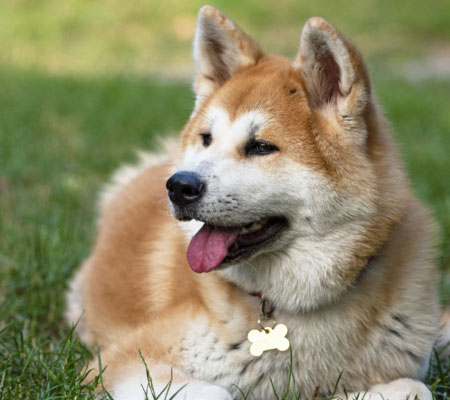The Canadian Eskimo dog (or Canadian Inuit dog)
is a huge dog that weighs between 66 and 95 pounds (30 to 43 kilograms).
The dog has the appearance of a giant husky or
malamute. With tiny, pointed ears, the head is wedge-shaped. The eyes are
almond-shaped and dark brown to amber in tone. Blue eyes are a sign of
impurity. In true husky form, the tail curls over the back. The average age of
maturity for Canadian Eskimo dogs is three years, while they achieve full size
in about a year.
The coat of the Canadian Eskimo dog is rough and
double-coated. White, brown and white, grey, grey and white, red and white, and
black and white are some of the hues available. Eskimo dogs in Canada shed or
blow coat.
Canadian Eskimo Dog Highlights
Breed Size
Large
Nature
Gentle, Friendly, Playful, Outgoing, Willful
Energy Level
Active
Intelligence
High
Barking Level
Infrequent
Coat Length
Short
Breed Group
Working
Droll Amount
Low
Good with
Familes, Children, Dog
Feed Level
Medium, High
Colour Type
White, liver, grey, black, black and white, red
Other Facts
Easy to groom, easy to train, easy to kept at home, easy for walk.
Dog History
The Inuit or Eskimo people of Canada created the
Canadian Eskimo dog around 4,000 years ago. These canines were raised to pull
sleds and assist Inuit hunters in the field.
Canadian Eskimo dogs were utilised frequently by
explorers to both the North and South poles, including both Peary and Amundson.
The dogs were utilised at an Australian Antarctic station until 1992. These
canines, who are descendants of the first expedition dogs, are currently based
in Minnesota.
The Canadian Eskimo dog is a United Kennel
Club-recognized breed. Some canines still remain with their native people, but
the dog began to dwindle with the invention of the snowmobile. The breed was
nearly extinct in the late 1960s. Because of the Inuits' increasing interest in
their cultural history, the breed is making a resurgence in Greenland and
elsewhere.
22-27 inch 28-39 kg 13-15 year
Height

Weight

Life Span
Health and Care
Because of its broad foundation line, the
Canadian Eskimo Dog is an usually healthy breed that is not affected by
inbreeding. Hip dysplasia, stomach torsion, entropion, cataracts, heat
intolerance, and arthritis are among minor health concerns that the breed is
prone to, as are other breeds.
Care
Because Canadian Eskimo Dogs are a high-energy
breed, they require a high-quality, age-appropriate dog food, which can be
purchased or cooked at home (with a veterinarian's supervision and consent).
Walrus, seal, caribou, and salmon have all been part of their diet in the past.
This breed is noted for working hard while
receiving very little food. As a result, Canadian Eskimo Dogs rarely overeat.
Even so, it's critical to keep track of the quantity of food you feed your dog
and to cut portions or limit calories if they gain weight. Also, keep in mind
that providing too many snacks in addition to normal meals might lead to
obesity.
Dog Breed Care Tips and
Important Instructions
Brushing your Canadian Eskimo Dog's thick coat
once a week can help keep it looking excellent. However, in order to induce
shedding of the dense undercoat, this breed requires special brushing in the
late summer. A coat rake, as well as matted fur, can aid with this (which can
lead to skin problems).
Canadian Eskimo Dogs, like other dogs, require
regular nail trimming, ear cleanings, and dental care, which includes at-home
teeth brushing as well as annual professional dental cleanings.
Canadian Eskimo Dogs were designed to transport
huge loads over great distances, travelling up to 40 miles per day on average.
As a result, it should come as no surprise that kids need to be physically
active on a daily basis. A simple walk around the block is insufficient. This
breed requires a lot of outdoor activity as well as plenty of area to run
around.
Even if they do get it, Canadian Eskimo Dogs may
search for ways to break away and run about. To prevent climbing and digging, a
tall, partially buried fence is essential.
The training of Canadian Eskimo Dogs should begin
when they are puppies. Positive, reward-based tactics will aid in the
establishment of a pack order with you as the leader, not the dog. And you'll
be able to better regulate the breed's guarding characteristics as a result.
Even strangers may be friendly and appreciate
attention from Canadian Eskimo Dogs. Early socialisation, on the other hand, is
critical for fostering those habits. Even after extensive training, Canadian
Eskimo Dogs must be kept away from youngsters. They should also not be let to
run loose in unguarded locations.
Feeding
Between the ages of eight and twelve weeks,
Canadian Eskimo Dog puppies require four bowls of food every twenty-four hours.
Canadian eskimo dog puppies from 3 to 6 months
should be fed three meals every 24 hours.
Puppies should be fed two meals every day from
the age of six months to one year.
When your Canadian eskimo dog reaches her first
birthday, she usually only requires one meal each day.
Adult Canadian eskimo dogs, on the other hand,
consume two smaller meals. It is your obligation to become acquainted with the
dietary habits of your Canadian Eskimo Dog.
Adult Canadian eskimo dogs get a balanced diet
from high-quality dry dog food, which they can combine with broth, water, or
canned food. Fruits and vegetables, cottage cheese, and boiled eggs are all
acceptable additions to your Canadian eskimo dog's diet, but they should not
account for more than 10% of his or her daily calories. Puppies of Canadian
Eskimo Dogs should be fed high-quality, brand-name puppy food. Please limit
your intake of "table food," since it can cause vitamin and mineral
deficiencies, dental and bone problems, as well as finicky eating habits and
obesity. Clean, drinkable water should be used solely, and food and water bowls
should be cleaned on a regular basis.
Fun Facts
They are a rare breed.
The Canadian Eskimo Dog has been living and
working with the Inuit people of Northern Canada for almost 4,000 years. The
dogs were utilised for sled pulling and hunting, and they were devoted friends
in the hard environment.
They were on the verge of
extinction.
In the 1960s, the Canadian Eskimo Dog was on the
verge of extinction, owing in part to the introduction of snowmobiles as a mode
of transportation, but also to a mass slaughter of the dogs by RCMP forces on
government orders, a fact that has been hotly debated and dismissed as a
conspiracy in some circles. This was compounded by the widespread introduction
of Huskies to the area, canines with more activity and stamina that finally
supplanted the Eskimo dogs.
Breeders are rescuing them
from extinction.
By 1963, the Canadian Kennel Club (CKC) studbook
had just one Canadian Eskimo Dog, and the breed had been declared extinct. With
the help of the Canadian government and the CKC, committed breeders began
searching distant parts of the Canadian Arctic for purebred Eskimo dogs, which
they eventually found. A breeding programme was started, and numbers
progressively increased.
Home Training Tips and General
Information
To avoid a Canadian Eskimo Dog feeling hesitant
and to ensure that they can learn orders quickly, just one person should teach
your Canadian Eskimo Dog in the beginning. When there are too many people
attempting to teach your Canadian Eskimo Dog at the same time, progress will be
slowed.
Positive reinforcement and feedback must be taken
advantage of. If a Canadian Eskimo Dog performs admirably, you should praise
him and treat him so that he understands what he did was wonderful. Never
chastise a Canadian Eskimo Dog for not understanding and obeying directions.
Because Canadian Eskimo Dogs aren't as intelligent as humans, they take longer
to learn. What you must understand is that they may not simply follow your
instructions the first time you educate them; educating a Canadian Eskimo Dog
successfully needs repetition. Don't chastise the Canadian Eskimo Dog since he
may acquire timidity, which will impede his ability to learn and desire to be
broken in. Trainers may offer them treats or food to show their appreciation for
your Canadian Eskimo Dog.
One at a time, provide instructions. Attempt to
teach him one command at a time. If he can't remember it, simply stick with
that talent since adding other lessons would most likely confuse the Canadian
Eskimo Dog. Put your trust in the basics.
Keep your tone pleasant when giving instructions
so the Canadian Eskimo Dog will eagerly accept your orders. A low, coaxing
voice elicits a response from Canadian Eskimo Dogs. If you shout at him, he may
become shocked and unresponsive.
Train a Canadian Eskimo Dog in a variety of
settings. If you keep your Canadian Eskimo Dog in a single setting, such as
your house, he will be unable to adjust to a new location with new people. Take
him to a dog park or a walk around the neighbourhood with him. This can help
your Canadian Eskimo Dog become used to various breeds and people.
FAQS
|
Is it possible for Canadian Eskimo dogs to survive in hot weather? |
|
The Canadian Eskimo Dog is a breed that is well-suited to the Arctic's
cold and severe weather. As a result, these canines are more adapted to
sub-zero conditions and are less flexible. Because of their thick coats, they
can quickly overheat in hot temperatures and should not be overworked in the
summer. |
|
Is it simple to teach Canadian Eskimo dogs? |
|
Unlike other spitz breeds, Canadian Eskimo dogs are relatively easy to
teach and take up commands rapidly during training. These dogs are considered
to be extremely bright and, in order to learn well, they typically require an
authoritative and stern training instructor. |
|
Is it possible to have a Canadian Eskimo dog as a pet? |
|
The Canadian Eskimo Dog is a great working dog that is dependable, loyal,
and smart. They are also friendly dogs who make excellent companions and
build strong ties with their owners. |
|
Is it true that Canadian Eskimo dogs are uncommon? |
|
Only 300 purebred dogs were estimated in 2008, putting the breed on the
verge of extinction. Although traditional working dog teams were originally
the predominant mode of transportation for Inuit in the Canadian Arctic, they
became more scarce in the 1960s. |
|
What was the purpose of the euthanasia of Canadian Eskimo dogs? |
|
By 1963, the Canadian Kennel Club had just one "Canadian Eskimo
dog" registered, and the breed had been declared extinct. The dogs were
murdered, according to the RCMP, for grounds of public health and safety.
They were enforcing the Ordinance Respecting Dogs in several cases. |
Canadian Eskimo Dog Unique Name
| Male Name | Female Name |
|---|---|
| Brownie | Brooklyn |
| Colby | Camilla |
| Dane | Candy |
| Fritz | Cinnamon |
| Luke | Diva |
| Maximus | Hannah |
| Morrisc | Maya |
| Nero | Miley |
| Nico | Minnie |
| Noah | Muffin |
| Norm | Paisley |
| Rudy | Sierra |
| Sarge | Sydney |
| Sawyer | Zoe |
| Vince | Butter |
| Yogi | Cherokee |
| Arlo | Keesha |
| Twinkle | Patsy |
| Volvo | Tessie |
| Wiz | Frankie |





